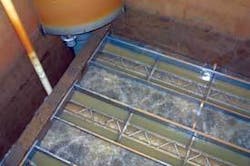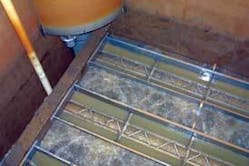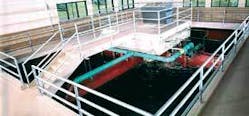Excessive nutrient discharges into receiving water bodies cause algae and phytoplankton blooms, which deplete the oxygen in the water. In some receiving water bodies, such as the Chesapeake Bay, this condition has caused the US EPA to list the water bodies as ‘impaired waters’ under the Clean Water Act. While not all nutrient sources can be easily controlled, discharge limits for wastewater treatment plants (WWTP) on sensitive receiving waters are being tightened.
In a typical WWTP, the majority of nitrogen in the secondary effluent consists of nitrates. In order to remove these nitrates biologically, nitrogen in the wastewater can be reduced by using nitrates as an electron acceptor in the denitrification step. Tertiary media filters can be used as the medium for denitrification while adding methanol as a carbon source (i.e., substrate). This process eventually converts nitrates to nitrogen gas. In this scenario, the denitrification process is an enhancement to the suspended solids removal capabilities of tertiary media filters. The denitrification process is able to reduce the total effluent nitrogen concentration to below 3.0 mg/L, which is the discharge limit for most sensitive water bodies.
The General Filter CenTROL filter from Siemens Water Technologies can be equipped for nitrogen removal by denitrification. The filter system clusters four filter cells around a central control column for convenient access to the cells from a common operating platform. With this arrangement, each filter cell shares a common cell wall with at least two other cells. The clustered structure simplifies the system layout and reduces materials required for the filter structure. Installation time and cost are reduced, as the factory fabricated control column replaces the influent and waste piping of conventional layout filter systems.
Water enters the filter through a common flume where the carbon source may be fed prior to water entering the distributor. Inside the distributor, integral flow splitting weirs and influent pipes evenly split the flow between all on-line filter cells without the use of modulating flow controllers. If a cell is taken off line, the flow is automatically divided between the remaining cells.
The water passes downward through the filter media where nitrates and suspended solids are removed. An open plenum underdrain below the media collects treated effluent and directs it to a common effluent chamber, where effluent nitrate concentration may be monitored. Finally, the water flows over an effluent weir for further treatment or discharge. The effluent weir is positioned to maintain a positive head on the filter cells at all times, and establishes a minimum cell water level.
Selection of the filter media is based on plant operating conditions and effluent water quality requirements. Essentially, this becomes a function of the denitrification rates required, the suspended solids removal rates required, and nitrogen gas accumulation. While a range of media types and sizes may be used, a lower specific gravity media such as anthracite reduces the required washing rate.
During operation, nitrogen gas that is produced becomes entrapped in the filter media and is sensed as false headloss. Periodic gas removal is accomplished by reversing flow for a short period of time through the media bed. Sensing instruments monitoring the cell water level will confirm headloss recovery upon completion of the gas removal step.
Unlike many other denitrification filter designs, the waste collection troughs in a CenTROL filter are located near the filter media to reduce the backwash waste volume required to wash out accumulated solids. Specially designed media retention baffles prevent loss of media during gas removal and backwash sequences.
The denitrification enhancement can also be adapted to existing filter systems. For cluster style filters, upgrading for denitrification will require adding a carbon feed system and converting the filter system as described previously. Conventional layout filter systems currently in use for suspended solids removal may also be converted for denitrification. This will require, at a minimum, adding a carbon feed system and modifying the control strategy. Typically, the wash troughs in these filters are located near the media, where the media retaining baffles could be retrofitted to maintain trough location. Additional modifications will depend on the existing equipment, but may include adding an air scour system, or replacing the underdrain and wash troughs.




